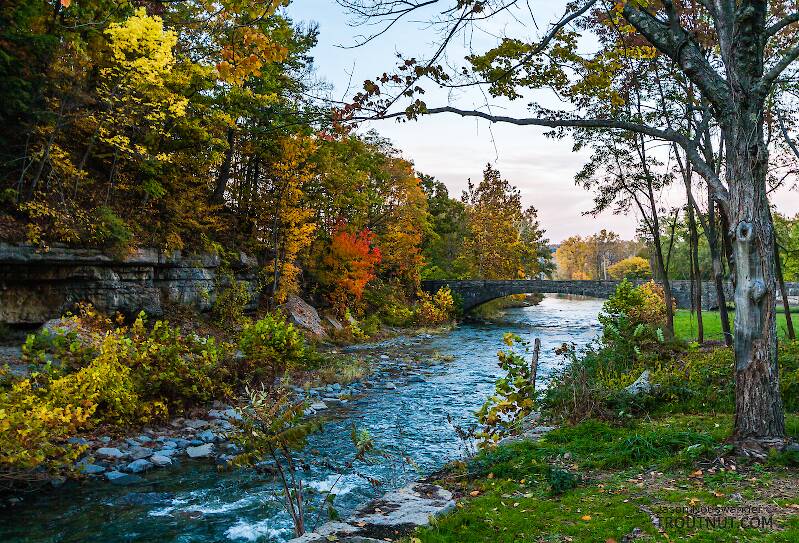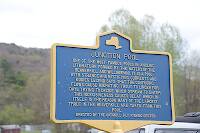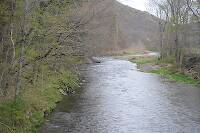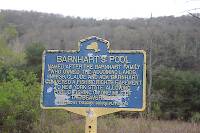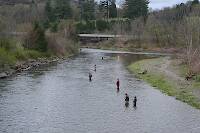
Blue-winged Olives
Baetis
Tiny Baetis mayflies are perhaps the most commonly encountered and imitated by anglers on all American trout streams due to their great abundance, widespread distribution, and trout-friendly emergence habits.
Featured on the forum

This one was surprisingly straightforward to identify. The lack of a sclerite at the base of the lateral hump narrows the field quite a bit, and the other options followed fairly obvious characteristics to Clostoeca, which only has one species, Clostoeca disjuncta.

Troutnut is a project started in 2003 by salmonid ecologist Jason "Troutnut" Neuswanger to help anglers and
fly tyers unabashedly embrace the entomological side of the sport. Learn more about Troutnut or
support the project for an enhanced experience here.
Oldredbarn has attached this picture. The message is below.
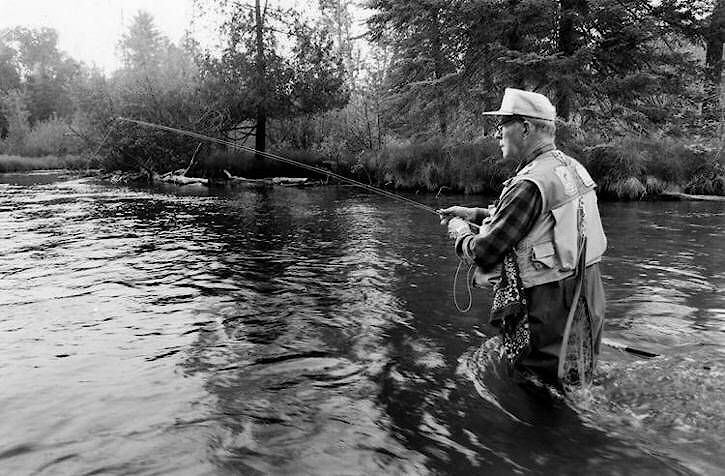
Oldredbarn on Oct 9, 2009October 9th, 2009, 2:56 am EDT
"Even when my best efforts fail it's a satisfying challenge, and that, after all, is the essence of fly fishing." -Chauncy Lively
"Envy not the man who lives beside the river, but the man the river flows through." Joseph T Heywood
"Envy not the man who lives beside the river, but the man the river flows through." Joseph T Heywood
Oldredbarn on Oct 9, 2009October 9th, 2009, 3:07 am EDT
GONZO...Just one question here...If it was good enough for Chauncey what's stopping you from wetting a line in the "Holy Water"???
Spence
Spence
"Even when my best efforts fail it's a satisfying challenge, and that, after all, is the essence of fly fishing." -Chauncy Lively
"Envy not the man who lives beside the river, but the man the river flows through." Joseph T Heywood
"Envy not the man who lives beside the river, but the man the river flows through." Joseph T Heywood
Lastchance on Oct 9, 2009October 9th, 2009, 4:09 am EDT
What a treasure. What year was this photo taken?
Oldredbarn on Oct 9, 2009October 9th, 2009, 4:29 am EDT
Lastchance,
Do a google search, actually a google image search. Type in "Chauncey Lively on the Au Sable"...The first three images are of the front cover of the Angler's of the Au Sable's newsletter called the "Riverwatch". Follow the link(s) to web page and download and read issue's 34 & 35. Issue 34 has an obit and a few articles written about Chauncey from friends he knew from up there and a few nice photos. I think he passed in Feb of 2000.
Spence
Do a google search, actually a google image search. Type in "Chauncey Lively on the Au Sable"...The first three images are of the front cover of the Angler's of the Au Sable's newsletter called the "Riverwatch". Follow the link(s) to web page and download and read issue's 34 & 35. Issue 34 has an obit and a few articles written about Chauncey from friends he knew from up there and a few nice photos. I think he passed in Feb of 2000.
Spence
"Even when my best efforts fail it's a satisfying challenge, and that, after all, is the essence of fly fishing." -Chauncy Lively
"Envy not the man who lives beside the river, but the man the river flows through." Joseph T Heywood
"Envy not the man who lives beside the river, but the man the river flows through." Joseph T Heywood
GONZO on Oct 9, 2009October 9th, 2009, 7:05 am EDT
GONZO...Just one question here...If it was good enough for Chauncey what's stopping you from wetting a line in the "Holy Water"???
Nothing, Spence...except poverty, work, and the limitations that both currently place on my ability to travel.
There is a long list of places in the Midwest that I would dearly love to visit and fish, and the Au Sable is certainly very high on that list. I feel a connection to that area by way of some Chippewa heritage, and I have the same respect for folks like George Griffith, Art Neumann, George Mason, and others that you do for Vince, Charlie, and Chauncy.
As much as we like to tease one another from time to time, the exchange between Easterners and Midwesterners has been one of the great things about Troutnut from the beginning. And both groups tolerate the Westerners because so many of their homewaters are also on our lists. :)
Anyway, thanks for the photo. Maybe I'll yet have a chance to move the Au Sable from the list of places that I want to fish to the list of places fished. But the first list seems to always be expanding, and time and opportunity inevitably contract....
Oldredbarn on Oct 9, 2009October 9th, 2009, 8:24 am EDT
GONZO,
I hear you brother! Just last night I was on the phone with the guy that got me in to fly fishing years ago. I told him that some evenings I head downstairs to tie and I feel the stresses of the day and sometimes feel like I'm rushing my work. I told him that at 55 I am sometimes bothered by the conflict between what I want to do and the things that have to get done...work etc... If I have a little problem handling some material or something at the tying table I get flustered and it can take the fun out of it.
He really didn't have a solution to my problems, but he was a listening ear with smart-ass remarks peppered in his conversation as only a good friend can get away with. He retired at the end of this last year and he can't stop reminding me of this just about every time we speak.
The half dozen names of "River-Gods" you mentioned in your last post could fill volumes. My fishing partner likes to call me "Mr. Lore" but it was he that introduced me to most of it. We have a stretch that we called simply, "The Wade"...In this section there are very famous places, amongst us anglers, and responsable for a great deal of good angling knowledge.
In this stretch is Mr. Griffiths, "Barbless Hook" where TU came in to being in 1959. There is a stone on his dock with a plaque explaining this. He also has a large sign there aimed at the canoests to leave the river as they found it.
There is a place close to my heart called the Thunderbird Club where Ernie Schwiebert was know to fish. There is the "Ginger Quill" which belonged to Carl Richards of "Selective Trout" fame...etc. When I fish this stretch it's like fishing with the ghosts of angling history. At the Lower TU access site there is a large boulder with a plaque in it with a saying by Art Neumann...This year a huge red pine came down there right across the boulder.
Anyway! I just want to say that I guess we have the same names on our short list. Isn't the internet wonderful! If that old Au Sable somehow forces itself to the top of you list just let me know and I just might have to show you some of these places...I haven't even mentioned Mr Mason...He died in 1954, the year I was born, and I have sections of the Mason Tract that I probably could fish with blinders on...
Take Care!
Spence
I hear you brother! Just last night I was on the phone with the guy that got me in to fly fishing years ago. I told him that some evenings I head downstairs to tie and I feel the stresses of the day and sometimes feel like I'm rushing my work. I told him that at 55 I am sometimes bothered by the conflict between what I want to do and the things that have to get done...work etc... If I have a little problem handling some material or something at the tying table I get flustered and it can take the fun out of it.
He really didn't have a solution to my problems, but he was a listening ear with smart-ass remarks peppered in his conversation as only a good friend can get away with. He retired at the end of this last year and he can't stop reminding me of this just about every time we speak.
The half dozen names of "River-Gods" you mentioned in your last post could fill volumes. My fishing partner likes to call me "Mr. Lore" but it was he that introduced me to most of it. We have a stretch that we called simply, "The Wade"...In this section there are very famous places, amongst us anglers, and responsable for a great deal of good angling knowledge.
In this stretch is Mr. Griffiths, "Barbless Hook" where TU came in to being in 1959. There is a stone on his dock with a plaque explaining this. He also has a large sign there aimed at the canoests to leave the river as they found it.
There is a place close to my heart called the Thunderbird Club where Ernie Schwiebert was know to fish. There is the "Ginger Quill" which belonged to Carl Richards of "Selective Trout" fame...etc. When I fish this stretch it's like fishing with the ghosts of angling history. At the Lower TU access site there is a large boulder with a plaque in it with a saying by Art Neumann...This year a huge red pine came down there right across the boulder.
Anyway! I just want to say that I guess we have the same names on our short list. Isn't the internet wonderful! If that old Au Sable somehow forces itself to the top of you list just let me know and I just might have to show you some of these places...I haven't even mentioned Mr Mason...He died in 1954, the year I was born, and I have sections of the Mason Tract that I probably could fish with blinders on...
Take Care!
Spence
"Even when my best efforts fail it's a satisfying challenge, and that, after all, is the essence of fly fishing." -Chauncy Lively
"Envy not the man who lives beside the river, but the man the river flows through." Joseph T Heywood
"Envy not the man who lives beside the river, but the man the river flows through." Joseph T Heywood
Oldredbarn on Jan 31, 2012January 31st, 2012, 7:00 am EST
I am moving this over here to continue the Chauncey thread and not continue to tramp all over the "Rusty Spinner" one...
The following is from an email I sent a friend mentioning a meeting I had with Chauncey back in 1997 at the Angler's of the Au Sable's 10th anniversary that was held in Gaylord MI.
We are having our 25th anniversay on the last Saturday in April (Opening Day) again up in Gaylord. Since I screwed up and missed last time (the 20th), mostly due to re-hab, post back surgery that Feb of 2007, I purchased a whole damn table upfront! Me and some "old-school" chums are going to get toasted! :)
If you read some of the links to the Angler's newsletter about Chauncey you will see he was a board member from the get-go...I'll try and move them here.
Spence
The following is from an email I sent a friend mentioning a meeting I had with Chauncey back in 1997 at the Angler's of the Au Sable's 10th anniversary that was held in Gaylord MI.
Check it out…I was at the 10th in 97 (I think that was the year) and unfortunately missed the 20th. At the tenth I had the chance to meet and had a nice conversation with Chauncey Lively…I was like a little kid and rambled on with a zillion tying questions and remember a somewhat puzzled kind smile on his face like a grandfather might have for his overly inquisitive grandson…
There was a wonderful “Anniversary” cane rod being auctioned off. It was a Bob Summers rod. A 4wt…I must have walked past it a hundred times during the night and had my wife not been there… Actually she probably wouldn’t have stopped me if I really wanted it…I went back thinking I’d bid and saw that the last offer was from Rusty…I didn’t want to over bid him…Later he said to me, “What the hell do I need another rod for Spence?! I’ll sell it to you for what I paid for it.” I still regret passing on this one. I wonder what happened to that rod?
Spence
We are having our 25th anniversay on the last Saturday in April (Opening Day) again up in Gaylord. Since I screwed up and missed last time (the 20th), mostly due to re-hab, post back surgery that Feb of 2007, I purchased a whole damn table upfront! Me and some "old-school" chums are going to get toasted! :)
If you read some of the links to the Angler's newsletter about Chauncey you will see he was a board member from the get-go...I'll try and move them here.
Spence
"Even when my best efforts fail it's a satisfying challenge, and that, after all, is the essence of fly fishing." -Chauncy Lively
"Envy not the man who lives beside the river, but the man the river flows through." Joseph T Heywood
"Envy not the man who lives beside the river, but the man the river flows through." Joseph T Heywood
Oldredbarn on Jan 31, 2012January 31st, 2012, 7:05 am EST
There is a long list of places in the Midwest that I would dearly love to visit and fish, and the Au Sable is certainly very high on that list. I feel a connection to that area by way of some Chippewa heritage, and I have the same respect for folks like George Griffith, Art Neumann, George Mason, and others that you do for Vince, Charlie, and Chauncy.
As much as we like to tease one another from time to time, the exchange between Easterners and Midwesterners has been one of the great things about Troutnut from the beginning. And both groups tolerate the Westerners because so many of their homewaters are also on our lists. :)
I moved this quote from G here per a request from Kurt...He was playfully teasing me from another thread about my insinuating, which I really wasn't, that us midwesterners & easterners had a monopoly on angling tradition...It's only in our heads Kurt...;)
Spence
http://www.ausableanglers.org/files/members/RIVERWATCH/RIVERWATCH34.pdf
Thanks Tony!
This link is to May 2000 issue of the Angler's of the Au Sables "Riverwatch" #34...Read Ed McGlinn's obit and some pics of Chauncey in this issue.
"Even when my best efforts fail it's a satisfying challenge, and that, after all, is the essence of fly fishing." -Chauncy Lively
"Envy not the man who lives beside the river, but the man the river flows through." Joseph T Heywood
"Envy not the man who lives beside the river, but the man the river flows through." Joseph T Heywood
Entoman on Jan 31, 2012January 31st, 2012, 10:36 pm EST
Great stuff Spence! Thank you for reviving the thread.
BTW - Check out the "look Inside" teaser for this book. It's a gooden'. My mentor was fishing this water in the early 30's and my great Uncle Earl well before the turn of the century. To the surprise of many, this region's recreational angling history goes back to the 1850's. Native rainbows in their home waters are magnificent. There's something about trout found where nature put them that's quite different. My opinion of brook trout changed entirely after my first trip to Maine.;) Hmmm... I'd sure like to fish for browns in Europe someday to test the hypothesis.
http://www.amazon.com/Shastas-Headwaters-Anglers-Sacramento-McCloud/dp/1571881360
BTW - Check out the "look Inside" teaser for this book. It's a gooden'. My mentor was fishing this water in the early 30's and my great Uncle Earl well before the turn of the century. To the surprise of many, this region's recreational angling history goes back to the 1850's. Native rainbows in their home waters are magnificent. There's something about trout found where nature put them that's quite different. My opinion of brook trout changed entirely after my first trip to Maine.;) Hmmm... I'd sure like to fish for browns in Europe someday to test the hypothesis.
http://www.amazon.com/Shastas-Headwaters-Anglers-Sacramento-McCloud/dp/1571881360
"It's not that I find fishing so important, it's just that I find all other endeavors of Man equally unimportant... And not nearly as much fun!" Robert Traver, Anatomy of a Fisherman
Oldredbarn on Feb 1, 2012February 1st, 2012, 5:47 am EST
Kurt...
I would like to read that one. There seems to be a lot of similar history between this area in the book you have here and the old Au Sable. I like reading about those "old days". On the Au Sable we had the logging era and a local guide who was an Indian, Chief Shoppenagon who was very colorful. We also had a consevation officier that was influential...Ours was Rube Babbitt who gave us the first plantings of Brooks in the system...etc.
I have an old book called "The Old Au Sable" by a doctor Hazen Miller that traces the river's history from pre-settlement days, through the logging era, etc.
You have a great many rivers out your way that have contributed a great deal to the fly fishing history. I love reading Ernie's stories about fishing the western Pacific drainages. Hemingway's brother on the Rogue etc.
One day I'll make it out that way...:)
Spence
I would like to read that one. There seems to be a lot of similar history between this area in the book you have here and the old Au Sable. I like reading about those "old days". On the Au Sable we had the logging era and a local guide who was an Indian, Chief Shoppenagon who was very colorful. We also had a consevation officier that was influential...Ours was Rube Babbitt who gave us the first plantings of Brooks in the system...etc.
I have an old book called "The Old Au Sable" by a doctor Hazen Miller that traces the river's history from pre-settlement days, through the logging era, etc.
You have a great many rivers out your way that have contributed a great deal to the fly fishing history. I love reading Ernie's stories about fishing the western Pacific drainages. Hemingway's brother on the Rogue etc.
One day I'll make it out that way...:)
Spence
"Even when my best efforts fail it's a satisfying challenge, and that, after all, is the essence of fly fishing." -Chauncy Lively
"Envy not the man who lives beside the river, but the man the river flows through." Joseph T Heywood
"Envy not the man who lives beside the river, but the man the river flows through." Joseph T Heywood
Entoman on Feb 1, 2012February 1st, 2012, 2:47 pm EST
I look forward to it, my friend. The same the other way.
Yes, a lot of similarities. That's why I thought you might find it interesting.
Fun factoid: Most of us learned about Black Bart & his gang holding up stagecoaches either in school or watching old westerns, but what is interesting is that many robbed were actually wealthy sportsmen up from the city on their way to the Sacramento or McCloud sporting camps. Good thing he wasn't interested in their fly tackle!:)
Yes, a lot of similarities. That's why I thought you might find it interesting.
Fun factoid: Most of us learned about Black Bart & his gang holding up stagecoaches either in school or watching old westerns, but what is interesting is that many robbed were actually wealthy sportsmen up from the city on their way to the Sacramento or McCloud sporting camps. Good thing he wasn't interested in their fly tackle!:)
"It's not that I find fishing so important, it's just that I find all other endeavors of Man equally unimportant... And not nearly as much fun!" Robert Traver, Anatomy of a Fisherman
Oldredbarn on Feb 2, 2012February 2nd, 2012, 6:46 am EST
Hey! This is a shout-out to "Those Pennsylvania Boys"...Tell me/us something about George Daniel! He is a guest speaker at our rod show next month...A good friend of mine has just started reading his, "Dynamic Nymphing" and is raving about it.
Is there something in the water over there in PA?! :)
Spence
Dealing with bandito's &/or stray arrows would sure add a different feel to one's angling adventure! :)
Is there something in the water over there in PA?! :)
Spence
Fun factoid: Most of us learned about Black Bart & his gang holding up stagecoaches either in school or watching old westerns, but what is interesting is that many robbed were actually wealthy sportsmen up from the city on their way to the Sacramento or McCloud sporting camps. Good thing he wasn't interested in their fly tackle!:)
Dealing with bandito's &/or stray arrows would sure add a different feel to one's angling adventure! :)
"Even when my best efforts fail it's a satisfying challenge, and that, after all, is the essence of fly fishing." -Chauncy Lively
"Envy not the man who lives beside the river, but the man the river flows through." Joseph T Heywood
"Envy not the man who lives beside the river, but the man the river flows through." Joseph T Heywood
Entoman on Feb 2, 2012February 2nd, 2012, 6:15 pm EST
Dealing with bandito's &/or stray arrows would sure add a different feel to one's angling adventure! :)
Yeah, can you imagine? Like,"Hey guys, relax! They only shot the guy riding shotgun... So what they stole our money, watches, harassed/insulted our women, and ruffed us up a bit... We still have our tackle! The McCloud or bust!" :)
Come to think of it though, we're as tough as our forebears! Are we men , or are we meece? I mentioned above about wanting to go after Mr. Brownee in his native lands... Let's organize an early summer trip!
http://swittersb.wordpress.com/2011/03/16/fly-fishing-in-iran-with-amir-salehi/
"It's not that I find fishing so important, it's just that I find all other endeavors of Man equally unimportant... And not nearly as much fun!" Robert Traver, Anatomy of a Fisherman
Oldredbarn on Feb 3, 2012February 3rd, 2012, 4:24 am EST
We still have our tackle! The McCloud or bust!" :)
Thanks for the morning smile mister! That is funny.
Uhhh....I think I'll pass on the fly fishing trip to Iran...:)
Spence
"Even when my best efforts fail it's a satisfying challenge, and that, after all, is the essence of fly fishing." -Chauncy Lively
"Envy not the man who lives beside the river, but the man the river flows through." Joseph T Heywood
"Envy not the man who lives beside the river, but the man the river flows through." Joseph T Heywood
Martinlf on Feb 3, 2012February 3rd, 2012, 12:23 pm EST
Spence, George Daniel is absolutely the real deal. He took me out on a highly pressured spring creek last summer in low water conditions and tuned my nymphing like nobody's business. I know several fish I caught later that summerI wouldn't have had a clue about how to approach without his mentoring. Buy the book; I'm going through it with a pen very slowly this winter and picking up more ideas. If you meet him, give him my best.
"He spread them a yard and a half. 'And every one that got away is this big.'"
--Fred Chappell
--Fred Chappell
Oldredbarn on Feb 6, 2012February 6th, 2012, 7:52 am EST
Getting back to Chauncey...I don't know if I'll get in trouble here, been a dues payer since 1991 :), but the following was lifted from the Angler's of the Au Sable newsletter to members. They are republishing some gems from past issues because we are getting ready to celebrate 25 years...This was from Chauncey from 1989...He is speaking about the new regs (no-kill) for the Holy Water, which unfortunately caused some ill will, and a little about the history of such regs...
Looking Back
The news that the Michigan Court of appeals
had upheld No-Kill regulations on
the Holy Water came as a timely Christmas
present. I’m sure the collective
sighs of relief issued by our members
swept through the cedars and aspen in
Au Sable country like a spring breeze.
Hopefully, the bitterness engendered on
both sides of the issue will fade and all
parties will join hands to help our river
reach its great potential.
When the raucous cries of opposition to
No-Kill began to echo across Crawford
County in 1986 it occurred to me that
they had a strangely familiar ring. Thirty
years ago I had listened to the same
sad songs in Pennsylvania, where I was
a resident.
The concept of No-Kill, or Catch-and-
Release (or Fish-For-Fun, as it was
originally known) was the brainchild of
Dr. Al Hazzard, who was well-known
to many Michigan anglers. In 1952 he
suggested that excellent trout fishing
could be maintained in suitable streams
– even those in close proximity to large
metropolitan areas – by making it illegal
for fisherman to kill trout. It was a bold
concept which challenged the angler to
strip himself of all motivation except for
pure sport.
In 1954 two streams in Great Smoky
Mountains National Park became the
first to be managed under Fish-For-Fun,
No-Kill regulations. Public acceptance
was tentative at first but it soon gained
momentum and within a year or so the
new philosophy had many enthusiastic
adherents. In 1958, shortly after
Dr. Hazzard left Michigan and joined
the Pennsylvania Fish Commission,
he set aside the Left Branch of Young
Woman’s Creek and its tributaries as the
pioneer Fish-For-Fun project in Pennsylvania.
Located in a thinly-populated
country in the mountains, the fourteen
miles of specially-regulated water contained
within state forest land and immune
from owner conflict along its
banks. Under the No-Kill, Flies-Only
order the stream developed an impressive
wild trout population within a few
years and fishing was superb. Even
some of the old-timers admitted that
there were more and larger trout than in
the “good old days,” when only brook
trout swam in the pools.
For nearly five years Young Woman’s
Creek offered magnificent wild trout
fishing in a wilderness setting. It received
nationwide acclaim and other
states began to formulate similar management
schemes. But resentment was
building up in a few anglers from nearby
villages and with a politically-motivated
decision the project was abruptly
terminated. The No-Kill regulations
were removed and soon the Flies-Only
restrictions were eliminated. As expected,
hordes of fishermen moved in for the
kill and it wasn’t long before unrelenting
pressure brought about the demise
of the stream as a wild trout fishery.
An alarmed coterie of fly fishermen
girded forces and confronted the fish
commission with petitions bearing
thousands of names, seeking reinstatement
or No-Kill regulations on the Left
Branch. The pleas fell on deaf ears and
the commission insisted that it would
not consider such management in areas
where there was local opposition. The
deed was done and Young Woman’s
Creek was a dead issue. Dr. Hazzard retired
soon afterwards and it was a general
consensus he took early retirement
out of frustration with an impossible political
climate at the agency level.
But a seed had been sown and anglers
in other areas of the state began to clamor
for No-Kill projects on their local
streams. The commission acquiesced
and within a few years there were eight
No-Kill projects scattered throughout
Pennsylvania. Each project had been
requested by local anglers and general
acceptance was enthusiastic. However,
none of these were managed with a
view towards maintaining a pure wild
trout fishery as was Young Woman’s
Creek. Biological considerations were
disregarded in the selection of streams
and it became evident that several projects
were unsuitable (because of water
temperature problems, inadequate food
supplies, etc.) and eventually had to be
abandoned. Since the remaining projects
were short stretches of streams
(generally 1.5 miles or less), periodic
plantings of hatchery trout were made
to offset migration out of the regulated
water.
Meanwhile, conservation groups in
Pennsylvania became impatient with
the commission’s apparent lack of concern
for a wild trout program and confrontations
became more frequent and
an unlikely ally – runaway inflation.
Faced with wildly escalating expenses
in the 1970’s, the state found itself no
longer able to afford the expensive and
wasteful hatchery programs that had
been the hallmark of its fisheries endeavors.
For the first time in the commission’s
history it sent out survey
teams to evaluate the population in its
trout streams. Three years later the survey
was completed and the state was
obliged to publish its findings. Lo and
behold! There were indeed streams
in the state with substantial wild trout
populations, a fact long known by many
fishermen and independent biologists.
Known as Operation Future, a complete
re-structuring of the state’s coldwater
fisheries program got under way. No-
Kill regulations were assigned to protect
the best wild trout populations and at
long last, biology became the determiner
of management policy. Pennsylvania
has several high-quality spring creeks
and although most are less than five
miles long from source to mouth, they
generally carry good wild trout populations.
It is mainly on these streams
where No-Kill projects now are found
and their popularity attests to the quality
of their fishing. Pennsylvania still maintains
an extensive stocking program
on several other streams but when
knowledgeable fly fishers seek the best
fishing in the state they invariably head
for the No-Kill, wild trout streams. As
they say, that’s where it’s at!
- Chauncy Lively,
RIVERWATCH Winter 1989
"Even when my best efforts fail it's a satisfying challenge, and that, after all, is the essence of fly fishing." -Chauncy Lively
"Envy not the man who lives beside the river, but the man the river flows through." Joseph T Heywood
"Envy not the man who lives beside the river, but the man the river flows through." Joseph T Heywood
Quick Reply
Related Discussions
Topic
Replies
Last Reply
7
Jun 25, 2019
by Wbranch
by Wbranch
Re: Drunella cornuta on the Brodhead at Stroudsburg PA
In the Mayfly Species Drunella cornuta by Reify
In the Mayfly Species Drunella cornuta by Reify
11
Apr 24, 2014
by Brookyman
by Brookyman

